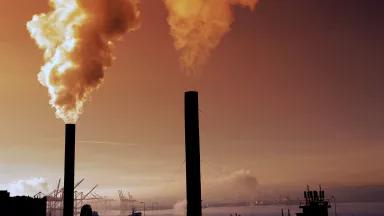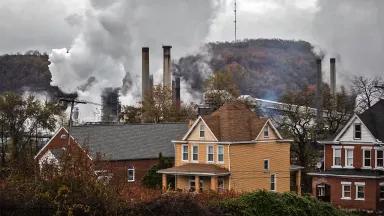Our Nation—and Its National Parks—Has a Smog Problem
The U.S. Environmental Protection Agency has proposed new rules to address air pollution. But experts worry it’s not enough.

A hazy sunset at Grand Teton National Park, Wyoming
Jon G. Fuller/VWPics/Universal Images Group via Getty Images
“Mmm, smell that fresh mountain air!” said a friend some years ago while we hiked through the Great Smoky Mountains National Park, which lies half in Tennessee and half in North Carolina.
“Actually, the Smokies have some of the worst air quality of any national park,” I said, repeating what a ranger had told me. I could feel the vibe dying as I said it.
I had been a volunteer with the park’s wildlife department, and like any good tour guide, I wanted to show my friend the sights—including Clingmans Dome, the park’s highest point and a popular stop for millions of yearly tourists hoping to catch a glimpse of the wispy, bluish clouds for which this mountain range was named.
These days, the Smokies are smokier than ever—though, instead of blue, it’s more of an off-white haze. It hangs over the mountains many days out of the year and cuts visibility from a maximum of 110 miles on clear days to just 5 miles or less during “severe haze episodes.”
Of course, the quality of your Instagram and TikTok posts is not the only thing in danger.
“That haze is made up of fine particulate matter, nitrogen oxides, and volatile organic compounds,” says Ulla-Britt Reeves, clean air campaigns director for the National Parks Conservation Association (NPCA). When those pollutants react with sunlight and heat, they form ground-level ozone, or smog.
Put another way: “It is a soup of man-made pollution,” says Reeves. “If you’re seeing it, you’re breathing it.”

Tennessee Valley Authority power plant in Kingston, Tennessee
Wade Payne/Bloomberg via Getty Images
Power plants are big polluters of national parks
To be clear, the smog haunting the Great Smoky Mountains isn’t coming from within the park—it’s drifting over from elsewhere in the region, such as coal-fired power plants owned by the Tennessee Valley Association and other industrial sources.
“Air pollution is carried by the wind, and it doesn’t respect state borders,” says John Walke, NRDC’s clean air director. “For example, perennial air pollution problems in New England and the mid-Atlantic are caused not just by local traffic or even local industry but in some cases, at greater than 50 percent, by power plants in Illinois, Indiana, Ohio, Pennsylvania, and West Virginia.”
The hazy situation in the Smokies, sadly, is not unique. According to a study published in Science Advances, the ozone levels measured in 33 national parks across the country between 1990 and 2014 were “statistically indistinguishable from the 20 largest U.S. metropolitan areas.”
“[Haze] is a soup of manmade pollution—If you're seeing it, you're breathing it.”
Ulla-Britt Reeves, clean air campaigns director for the National Parks Conservation Association
And whether it’s blurring the vistas of the Smokies, Utah’s Canyonlands, or Yosemite’s El Capitan, the air in our national parks becomes even unhealthier during the warm, sunny days of summer, when ozone is more likely to form in higher concentrations.
Air pollution is also harmful to ecosystems. Ozone, for instance, makes it more difficult for plants to produce and store food, and it can even inflict black wounds on leaves and other plant structures. A study on the Great Smoky Mountains National Park in the 1990s found that nearly half of all black cherry trees and as much as 79 percent of milkweed plants sampled showed signs of ozone damage. There’s even evidence out of Canada that the aerosolized lead in air pollution can be absorbed into the tissues of everything from wolverines to lichen. And the neurotoxin mercury, released from the burning of fossil fuels, has long been known to contaminate aquatic ecosystems and accumulate in higher and higher concentrations as it travels up the food chain.
“Fine particulate matter is known to actually bioaccumulate in the same way that mercury does,” says Reeves. “So it’s really not safe for wildlife, either.”
Why fine particle pollution matters
A major contributor to smog is fine particle pollution, which is just what it sounds like—itty bitty particles of nastiness. At a mere 2.5 microns across or less, these particles are so small that they are able to penetrate deep within your lungs and into your bloodstream. From there, the particulate matter (also known as PM2.5 for its size) causes all sorts of health issues, from asthma to heart attacks to death. A 2019 study found that, globally, PM2.5 kills roughly one in five people prematurely. Published last year, another huge study that looked at the health data and outcomes of 68.5 million older Americans found that even a slight decrease in allowable levels of soot would have saved 143,000 lives over the course of a decade.
The good news is that earlier this year, the U.S. Environmental Protection Agency (EPA) did propose lowering the allowable levels for PM2.5. The bad news is that the agency still needs to go lower.
Since 1970, the National Ambient Air Quality Standards, or NAAQS, have been setting limits on six major air pollutants. The EPA bases the limits on how certain levels of exposure affect public health, including for sensitive groups such as children, the elderly, and people with asthma, as well as the pollutants’ impact on animals, plants, buildings, and visibility. In addition, each standard takes into account exposure levels over different periods of time. For PM2.5, the standards seek to limit how much someone breathes in over the course of a single day as well as over a year.
The EPA periodically updates the standards and its current proposal suggests limiting the annual standard for PM2.5 from 12 micrograms (mg) per cubic meter to between 9 and 10 mg. Such a change, the EPA says, has the potential to prevent up to 4,200 premature deaths a year. The agency, however, is not proposing to change the current daily exposure limit of 35 mg per cubic meter.
“Any strengthening of the standard is welcome, and we are pleased that EPA is proposing to do something at all,” says Reeves. “But it certainly doesn't go far enough.”

A cyclist on a path near a Rio Tinto refinery and shipping operation in Wilmington, California
Ann Johansson for NRDC
Why the EPA needs to be stronger on PM2.5
The American Lung Association and other nonprofit groups, including NRDC, are also urging the Biden administration to go as low as it can on particle pollution protections. The EPA is currently reviewing public comments on annual and daily standards for PM2.5 that go as low as 8 mg and 25 mg per cubic meter, respectively.
The decision not to lower the standard for how much particulate matter a person might encounter in a 24-hour period is particularly disappointing, Reeves says, because that’s the one that would protect people living closest to the sources of this pollution the most. “They’re marginalized communities, often people of color, often people of low income, and people who deserve way more protection than the EPA is affording them.”
While “micrograms per cubic meter” is not a metric most of us are very familiar with, we generally understand that less pollution in our lungs is better. Still, limits being advocated for by NRDC and NPCA are not arbitrary—they are based on a decade’s worth of scientific research that has found that PM2.5 is harmful at lower levels than previously thought. And it’s time to adjust the standards accordingly.
Further proof that the current limit for annual exposure is too high is seen in how seldom it’s exceeded. “Southern California is just about the only part of the country that regularly violates the current annual standard for PM2.5,” says Walke. It’s certainly no coincidence that in 2018, two parks in that region—Joshua Tree National Park and Mojave National Preserve—both had air that was unhealthy for visitors to breathe for more than two months of the year.
Today’s forecast: soot
Here’s another way to look at these standards: They inform the Air Quality Index that, in turn, informs you about what you may be breathing in on a daily basis.
“These are air quality warning systems,” says Walke. “Code red, code orange, code yellow. That’s the way that the government communicates with you, the population, about whether the air is safe or unsafe.”
Health advocates will continue to push the EPA to strengthen its protections against particle pollution, which the agency will finalize later this year. In the meantime, while you shouldn’t expect too much improvement in the amount of smog-free days you might enjoy this summer, it’s still a very good idea to keep tabs on your local air quality, especially if you or your loved ones belong to one of the groups most vulnerable to poor air quality. Check out sites and apps like AirNow, and when levels tip into orange and red, consider staying indoors instead—maybe take it as an opportunity to plan your next trip to a national park, under hopefully clearer skies.
This NRDC.org story is available for online republication by news media outlets or nonprofits under these conditions: The writer(s) must be credited with a byline; you must note prominently that the story was originally published by NRDC.org and link to the original; the story cannot be edited (beyond simple things such as grammar); you can’t resell the story in any form or grant republishing rights to other outlets; you can’t republish our material wholesale or automatically—you need to select stories individually; you can’t republish the photos or graphics on our site without specific permission; you should drop us a note to let us know when you’ve used one of our stories.
Scorching temperatures this summer are further proof that climate action can't wait.
Tell President Biden and Congress to enact game-changing action to confront the climate crisis!





Air Pollution: Everything You Need to Know
What Is the Air Quality Index?
How to Become a Community Scientist